Terahertz Sensor via Ultralow-Loss Dispersion-Flattened Polymer Optical Fiber: Design and Analysis
Abstract
:1. Introduction
2. Design Methodology
3. Simulation Results and Analyses
4. Conclusions
Author Contributions
Funding
Institutional Review Board Statement
Informed Consent Statement
Data Availability Statement
Acknowledgments
Conflicts of Interest
References
- Tonouchi, M. Cutting-edge terahertz technology. Nat. Photonics 2007, 1, 97–105. [Google Scholar] [CrossRef]
- Takayanagi, J.; Jinno, H.; Ichino, S.; Suizu, K.; Yamashita, M.; Ouchi, T.; Kasai, S.; Ohtake, H.; Uchida, H.; Nishizawa, N.; et al. High-resolution time-of-flight terahertz tomography using a femtosecond fiber laser. Opt. Express 2009, 17, 7533–7539. [Google Scholar] [CrossRef]
- Rutz, F.; Hasek, T.; Koch, M.; Ewert, U. Terahertz birefringence of liquid crystal polymers. Appl. Phys. Lett. 2006, 89, 221911. [Google Scholar] [CrossRef]
- Tian, K.; Li, J.; Yang, X. A novel method of micro-doppler parameter extraction for human monitoring terahertz radar network. Int. J. Antennas Propag. 2020, 2020, 1–13. [Google Scholar] [CrossRef]
- Madhavan, P.; Thamizharasi, T.; Ranjith, K.M.V.; Suresh, K. Numerical investigation of temperature dependent water infiltrated D-shaped dual core photonic crystalfiber (D-DC-PCF) for sensing applications. Results Phys. 2019, 13, 102289. [Google Scholar] [CrossRef]
- Islam, M.R.; Mohammad, R.I.; Md Moinul, I.K.; Fariha, M.; Jubair, A.C.; Mohibul, I. Design of a fabrication friendly & highly sensitive surface plasmon resonance-based photonic crystal fiber biosensor. Results Phys. 2020, 19, 103501. [Google Scholar]
- Shin, H.J.; Oh, S.J.; Kim, S.I. Conformational characteristics of beta-glucan in laminarin probed by terahertz spectroscopy. Appl. Phys. Lett. 2009, 94, 111911. [Google Scholar] [CrossRef]
- Arifin, A.; Agustina, N.; Dewang, S.; Idris, I.; Tahir, D. Polymer optical fiber-based respiratory sensors: Various designs and implementations. J. Sens. 2019, 2019, 1–6. [Google Scholar] [CrossRef]
- Zhao, R.; Lu, G.; Yin, H.; Liang, J.; Zeng, D.; Xiao, H. Terahertz sensor study based on spoof surface plasmon polaritons. Int. J. Antennas Propag. 2020, 2020, 1–13. [Google Scholar] [CrossRef]
- Islam, R.; Habib, S.; Hasanuzzaman, G.K.M.; Rana, S.; Sadath, M.A.; Markos, C. A novel low-loss diamond-core porous fiber for polarization maintaining terahertz transmission. IEEE Photonics Technol. Lett. 2016, 28, 1537–1540. [Google Scholar] [CrossRef] [Green Version]
- Krumbholz, N.; Gerlach, K.; Rutz, F. Omnidirectional terahertz mirrors: A key element for future terahertz communication systems. Appl. Phys. Lett. 2006, 88, 202905. [Google Scholar] [CrossRef]
- Xiao, H.; Li, H.; Wu, B.; Jian, S. Polarization-maintaining terahertz bandgap fiber with a quasi-elliptical hollow-core. Opt. Laser Technol. 2018, 105, 276–280. [Google Scholar] [CrossRef]
- Hasan, M.R.; Anower, M.S.; Hasan, M.I.; Razzak, S.M.A. Polarization maintaining low-loss slotted core kagome lattice THz fiber. IEEE Photonics Technol. Lett. 2016, 28, 1751–1754. [Google Scholar] [CrossRef]
- Islam, M.S.; Sultana, J.; Dinovitser, A.; Faisal, M.; Rakibul, M.; Ng, B.W.-H.; Abbot, D. Zeonex-based asymmetrical terahertz photonic crystal fiber for multichannel communication and polarization maintaining applications. Appl. Opt. 2018, 57, 666–672. [Google Scholar] [CrossRef]
- Stoik, C.D.; Bohn, M.J.; Blackshire, J.L. Nondestructive evaluation of aircraft composites using transmissive terahertz time domain spectroscopy. Opt. Express 2008, 16, 17039–17051. [Google Scholar] [CrossRef] [PubMed]
- Xu, Q.; Li, K.; Copner, N.; Lin, S. An ultrashort wavelength multi/demultiplexer via rectangular liquid-infiltrated dual-core polymer optical fiber. Materials 2019, 12, 1709. [Google Scholar] [CrossRef] [Green Version]
- Zhu, Y.; Huang, X.; Ke, Q.; Liu, G.; Rao, C.; Kong, D.; Mei, S.; Liu, Y.; Wang, H. Low loss and polarization-insensitive coupling length for a terahertz fiber directional coupler with symmetric dual-suspended core structure. Opt. Commun. 2021, 480, 126497. [Google Scholar] [CrossRef]
- Yuan, J.; Ning, T.; Li, H.; Pei, L.; Li, J.; Zheng, J.; Wan, L. Terahertz filters based on subwavelength polymer waveguide. Results Phys. 2019, 13, 102198. [Google Scholar] [CrossRef]
- Roggero, U.F.S.; Hernández-Figueroa, H.E. Polymeric power splitters for multiplexing optical biosensors. Opt. Laser Technol. 2020, 127, 106127. [Google Scholar] [CrossRef]
- Wang, B.; Tian, F.; Liu, G.; Bai, R.; Li, L.; Yang, X.; Zhang, J. A dual-core fiber for tunable polarization splitters in the terahertz regime. Opt. Commun. 2021, 480, 126463. [Google Scholar] [CrossRef]
- Yakasai, I.K.; Abas, P.E.; Suhaimi, H.; Begum, F. Low loss and highly birefringent photonic crystal fibre for terahertz applications. Optik 2020, 206, 164321. [Google Scholar] [CrossRef]
- Bai, J.; Ge, M.; Wang, S.; Yang, Y.; Li, Y.; Chang, S. Characteristics of a liquid-crystal-filled composite lattice terahertz bandgap fiber. Opt. Commun. 2018, 419, 8–12. [Google Scholar] [CrossRef]
- Kim, S.; Kee, C.; Lee, C.G. Modified rectangular lattice photonic crystal fibers with high birefringence and negative dispersion. Opt. Express 2009, 17, 7952–7957. [Google Scholar] [CrossRef]
- Pinto, A.R.; Lopez-Amo, M. Photonic crystal fibers for sensing applications. J. Sens. 2012, 2012, 1–21. [Google Scholar] [CrossRef] [Green Version]
- Sultana, J.; Islam, M.S.; Ahmed, K.; Dinovitser, A.; Ng, B.W.-H.; Abbott, D. Terahertz detection of alcohol using a photonic crystal fiber sensor. Appl. Opt. 2018, 57, 2426–2433. [Google Scholar] [CrossRef]
- Stawska, H.I.; Popenda, M.A.; Bereś-Pawlik, E. Anti-resonant hollow core fibers with modified shape of the core for the better optical performance in the visible spectral region—A numerical study. Polymers 2018, 10, 899. [Google Scholar] [CrossRef] [Green Version]
- Chaudhary, V.S.; Kumar, D. TOPAS based porous core photonic crystal fiber for terahertz chemical sensor. Optik 2020, 223, 165562. [Google Scholar] [CrossRef]
- Abdullah-Al-Shafi, M.; Sen, S. Design and analysis of a chemical sensing octagonal photonic crystal fiber (O-PCF) based optical sensor with high relative sensitivity for terahertz (THz) regime. Sens. Bio-Sens. Res. 2020, 29, 100372. [Google Scholar] [CrossRef]
- Qin, J.; Zhu, B.; Du, Y.; Han, Z. Terahertz detection of toxic gas using a photonic crystal fiber. Opt. Fiber Technol. 2019, 52, 101990. [Google Scholar] [CrossRef]
- Paul, B.K.; Ahmed, K. Highly birefringent TOPAS based single mode photonic crystal fiber with ultra-low material loss for Terahertz applications. Opt. Fiber Technol. 2019, 53, 102031. [Google Scholar] [CrossRef]
- Liu, Q.; Li, S.; Shi, M. Fiber Sagnac interferometer based on a liquid-filled photonic crystal fiber for temperature sensing. Opt. Commun. 2016, 381, 1–6. [Google Scholar] [CrossRef]
- Sun, B.; Chen, M.; Zhang, Y.; Zhou, J. Polarization-dependent coupling characteristics of metal-wire filled dual-core photonic crystal fiber. Opt. Quantum Electron. 2015, 47, 441–451. [Google Scholar] [CrossRef]
- Fan, Z.; Li, S.; Liu, Q.; Chen, H.; Wang, X. Plasmonic broadband polarization splitter based on dual-core photonic crystal fiber with elliptical metallic nanowires. Plasmonics 2016, 11, 1565–1572. [Google Scholar] [CrossRef]
- Benabid, F.; Knight, J.C.; Antonopoulos, G.; Russell, P.S.J. Stimulated Raman scattering in hydrogen-filled hollow-core photonic crystal fiber. Science 2002, 298, 399–402. [Google Scholar] [CrossRef] [PubMed]
- Sultana, J.; Islam, M.S.; Atai, J.; Islam, M.R.; Abbott, D. Near-zero dispersion flattened, low-loss porous-core waveguide design for terahertz signal transmission. Opt. Eng. 2017, 56, 076114. [Google Scholar] [CrossRef] [Green Version]
- Hassani, A.; Dupuis, A.; Skorobogatiy, M. Low loss porous terahertz fibers containing multiple subwavelength holes. Appl. Phys. Lett. 2008, 92, 071101. [Google Scholar] [CrossRef]
- Islam, M.R.; Kabir, M.F.; Talha, K.M.A.; Islam, M.S. A novel hollow core terahertz refractometric sensor. Sens. Bio-Sens. Res. 2019, 25, 100295. [Google Scholar] [CrossRef]
- Jin, Y.S.; Kim, G.J.; Jeon, S.G. Terahertz dielectric properties of polymers. J. Korean Phys. Soc. 2006, 49, 513–517. [Google Scholar]
- Pakarzadeh, H.; Rezaei, S.M.; Namroodi, L. Hollow-core photonic crystal fibers for efficient terahertz transmission. Opt. Commun. 2019, 433, 81–88. [Google Scholar] [CrossRef]
- Wang, D.; Chen, G.; Wang, L. Thermal tunability of photonic bandgaps in liquid crystal filled polymer photonic crystal fiber. Opt. Fiber Technol. 2016, 29, 95–99. [Google Scholar] [CrossRef]
- D’ Angelo, F.; Mics, Z.; Bonn, M.; Turchinovich, D. Ultra-broadband THz time-domain spectroscopy of common polymers using THz air photonics. Opt. Express 2014, 22, 12475–12485. [Google Scholar] [CrossRef] [PubMed] [Green Version]
- Argyros, A. Microstructured polymer optical fibers. J. Light.Technol. 2009, 27, 1571–1579. [Google Scholar] [CrossRef]
- Khanarian, G. Optical properties of cyclic olefin copolymers. Opt. Eng. 2001, 40, 1024–1029. [Google Scholar] [CrossRef]
- Hassani, A.; Gauvreau, B.; Fehri, M.F.; Kabashin, A.; Skorobogatiy, M. Photonic crystal fiber and waveguide-based surface plasmon resonance sensors for application in the visible and near-IR. Electromagnetics 2008, 28, 198–213. [Google Scholar] [CrossRef]
- Zhou, W.; Li, K.; Wei, Y.; Hao, P.; Chi, M.; Liu, Y.; Wu, Y. Ultrasensitive label-free optical microfiber coupler biosensor for detection of cardiac troponin I based on interference turning point effect. Biosens. Bioelectron. 2018, 106, 99–104. [Google Scholar] [CrossRef]
- Rifat, A.A.; Ahmed, R.; Yetisen, A.K.; Butt, H.; Sabouri, A.; Mahdiraji, G.A.; Yun, S.H.; Adikan, F.R.M. Photonic crystal fiber based plasmonic sensors. Sens. Actuators B Chem. 2007, 243, 311–325. [Google Scholar] [CrossRef]
- Møller, U.; Merbold, H.; Folkenberg, J.R.; Jepsen, P.U. Determination of alcohol concentration in aqueous solutions and food analysis using reflection terahertz time-domain spectroscopy. In Proceedings of the Joint 32nd International Conference on Infrared and Millimeter Waves and the 15th International Conference on Terahertz Electronics, Cardiff, UK, 2–9 September 2007; pp. 1–2. [Google Scholar]
- Qian, W.; Zhao, C.; He, S.; Dong, X.; Zhang, S.; Zhang, Z.; Jin, S.; Guo, J.; Wei, H. High-sensitivity temperature sensor based on an alcohol-filled photonic crystal fiber loop mirror. Opt. Lett. 2011, 36, 1548–1550. [Google Scholar] [CrossRef]
- Koshiba, M.; Saitoh, K. Structural dependence of effective area and mode field diameter for holey fibers. Opt. Express 2003, 11, 1746–1756. [Google Scholar] [CrossRef]
- Koshiba, M.; Saitoh, K. Numerical verification of degeneracy in hexagonal photonic crystal fibers. IEEE Photonics Technol. Lett. 2001, 13, 1313–1315. [Google Scholar] [CrossRef] [Green Version]
- Saitoh, K.; Koshiba, M. Full-vectorial imaginary-distance beam propagation method based on a finite element scheme: Application to photonic crystal fibers. IEEE J. Quantum Electron. 2002, 38, 927–933. [Google Scholar] [CrossRef]
- Zhu, Z.; Brown, T. Analysis of the space filling modes of photonic crystal fibers. Opt. Express 2001, 8, 547–554. [Google Scholar] [CrossRef] [PubMed]
- Arriaga, J.; Knight, J.C.; Russell, P.S.J. Modeling the propagation of light in photonic crystal fibers. Phys. D Nonlinear Phenom. 2004, 189, 100–106. [Google Scholar] [CrossRef]
- Rastogi, V.; Chiang, K.S. Holey optical fiber with circularly distributed holes analyzed by the radial effective-index method. Opt. Lett. 2003, 28, 2449–2451. [Google Scholar] [CrossRef] [PubMed]
- Knight, J.C.; Birks, T.A.; Russell, P.S.J. Properties of photonic crystal fiber and the effective index model. J. Opt. Soc. Am. A 1998, 15, 748–752. [Google Scholar] [CrossRef]
- Zhu, Z.; Brown, T.G. Full-vectorial finite-difference analysis of microstructured optical fibers. Opt. Express 2002, 10, 853–864. [Google Scholar] [CrossRef]
- Qiu, M. Analysis of guided modes in photonic crystal fibers using finite difference time domain method. Microw. Opt. Technol. Lett. 2001, 30, 40–42. [Google Scholar] [CrossRef]
- Feit, M.D.; Fleck, J.A., Jr. Light propagation in graded-index optical fiber. Appl. Opt. 1978, 24, 3990–3998. [Google Scholar] [CrossRef]
- Xiao, J.; Sun, X. A Modified full-vectorial finite-difference beam propagation method based on H-fields for optical waveguides with step-index profiles. Opt. Commun. 2006, 266, 505–511. [Google Scholar] [CrossRef]
- Xie, K.; Boardman, A.D.; Xie, M.; Yang, Y.J.; Jiang, H.M.; Yang, H.J.; Wen, G.J.; Li, J.; Chen, K.; Chen, F.S. A Simulation of longitudinally magnetized three-dimensional magneto-optical devices by a full-vectorial beam propagation method. Opt. Commun. 2008, 281, 3275–3285. [Google Scholar] [CrossRef]
- White, T.P.; Kuhlmey, B.T.; Mcphedran, R.C.; Maystre, D.; Renversez, G.; Sterke, C.M.D.; Botten, L.C. Multipole method for microstructured optical fibers. I. Formulation. J. Opt. Soc. Am. B 2002, 19, 2322–2330. [Google Scholar] [CrossRef] [Green Version]
- Kuhlmey, B.T.; White, T.P.; Renversez, G.; Maystre, D.; Botten, L.C.; Sterke, C.M.D.; Mcphedran, R.C. Multipole method for microstructured optical fibers. II. implementation and results. J. Opt. Soc. Am. B 2002, 19, 2331–2340. [Google Scholar] [CrossRef]
- White, T.P.; Mcpherdran, R.C.; Botten, L.C. Calculations of air-guided modes in photonic crystal fibers using the multipole method. Opt. Express 2001, 9, 721–732. [Google Scholar] [CrossRef] [Green Version]
- Large, M.C.J.; Ponrathnam, S.; Argyros, A.; Pujari, N.S.; Cox, F. Solution doping of microstructured polymer optical fibers. Opt. Express 2004, 12, 1966–1971. [Google Scholar] [CrossRef]
- Wang, J.; Yang, X.; Wang, L. Fabrication and experimental observation of monolithic multi-air-core fiber array for image transmission. Opt. Express 2008, 16, 7703–7708. [Google Scholar] [CrossRef]
- Zhang, Y.; Li, K.; Wang, L.; Ren, L.; Zhao, W.; Miao, R.; Large, M.C.J.; Eijkelenborg, M.A.V. Casting preforms for microstructured polymer optical fibre fabrication. Opt. Express 2006, 14, 5541–5547. [Google Scholar] [CrossRef]
- Eijkelenborg, M.A.V.; Argyros, A.; Barton, G.; Bassett, I.M.; Fellew, M.; Henry, G.; Issa, N.A.; Large, M.C.J.; Manos, S.; Padden, W.; et al. Recent progress in microstructured polymer optical fibre fabrication and characterisation. Opt. Fiber Technol. 2003, 9, 199–209. [Google Scholar] [CrossRef]
- Xu, Q.; Miao, R.; Zhang, Y. Highly nonlinear low-dispersion photonic crystal fiber with high birefringence for four-wave mixing. Opt. Mater. 2012, 35, 217–221. [Google Scholar] [CrossRef]
- Arif, M.F.H.; Ahemd, K.; Asaduzzaman, S.; Azad, M.A.K. Design and optimization of photonic crystal fiber for liquid sensing application. Photonic Sens. 2016, 6, 279–288. [Google Scholar] [CrossRef] [Green Version]
- Asaduzzaman, S.; Ahemd, K. Microarray-core based circular photonic crystal fiber for high chemical sensing capacity with low confinement loss. Opt. Appl. 2017, 47, 41–49. [Google Scholar]
- Asaduzzaman, S.; Ahmed, K. Proposal of a gas sensor with high sensitivity, birefringence and nonlinearity for air pollution monitoring. Sens. Bio-Sens. Res. 2016, 10, 20–26. [Google Scholar] [CrossRef] [Green Version]
- Ademgil, H. Highly sensitive octagonal photonic crystal fiber based sensor. Optik 2014, 125, 6274–6278. [Google Scholar] [CrossRef]
- Ademgil, H.; Haxha, S. PCF based sensor with high sensitivity, high birefringence and low confinement losses for liquid analyte sensing applications. Sensors 2015, 15, 31833–31842. [Google Scholar] [CrossRef] [Green Version]
- Rana, S.; Kandadai, N.; Subbaraman, H. A highly sensitive, polarization maintaining photonic crystal fiber sensor operating in the THz regime. Photonics 2018, 5, 40. [Google Scholar] [CrossRef] [Green Version]
- Islam, M.S.; Sultana, J.; Dinovitser, A.; Dinovitser, A.; Ahmed, K.; Islam, M.R.; Faisal, M.; Ng, B.W.-H.; Abbott, D. A novel Zeonex Based Photonic Sensor for Detection in Beverages. In Proceedings of the 2017 IEEE International Conference on Telecommunications and Photonics, Dhaka, Bangladesh, 26–28 December 2017; pp. 114–118. [Google Scholar]
- Asaduzzaman, S.; Ahmed, K.; Bhuiyan, T.; Farah, T. Hybrid photonic crystal fiber in chemical sensing. SpringerPlus 2016, 5, 748. [Google Scholar] [CrossRef] [PubMed] [Green Version]
- Paul, B.K.; Islam, M.S.; Ahmed, K.; Asaduzzaman, S. Alcohol sensing over O + E + S + L + U transmission band based on porous cored octagonal photonic crystal fiber. Photonic Sens. 2017, 7, 123–130. [Google Scholar] [CrossRef] [Green Version]
- Hasan, M.R.; Islam, M.A.; Anower, M.S.; Razzak, S.M.A. Low-loss and bend-insensitivity terahertz fiber using a rhombic-shape core. Appl. Opt. 2016, 55, 8441–8447. [Google Scholar] [CrossRef]
- Habib, M.A.; Anower, M.S. Low loss highly birefringent porous core fiber for single mode terahertz wave guidance. Curr. Opt. Photonics 2018, 2, 215–220. [Google Scholar]
- Singh, S.; Kaur, V. Photonic Crystal Fiber Sensor Based on Sensing Ring for Different Blood Components: Design and Analysis. In Proceedings of the 2017 Ninth International Conference on Ubiquitous and Future Networks, Milan, Italy, 4–7 July 2017; pp. 399–403. [Google Scholar]
- Islam, M.S.; Sultana, J.; Rifat, A.A.; Dinovitser, A.; Ng, B.W.-H.; Abbott, D. Terahertz sensing in a hollow core photonic crystal fiber. IEEE Sens. J. 2018, 18, 4073–4080. [Google Scholar] [CrossRef]

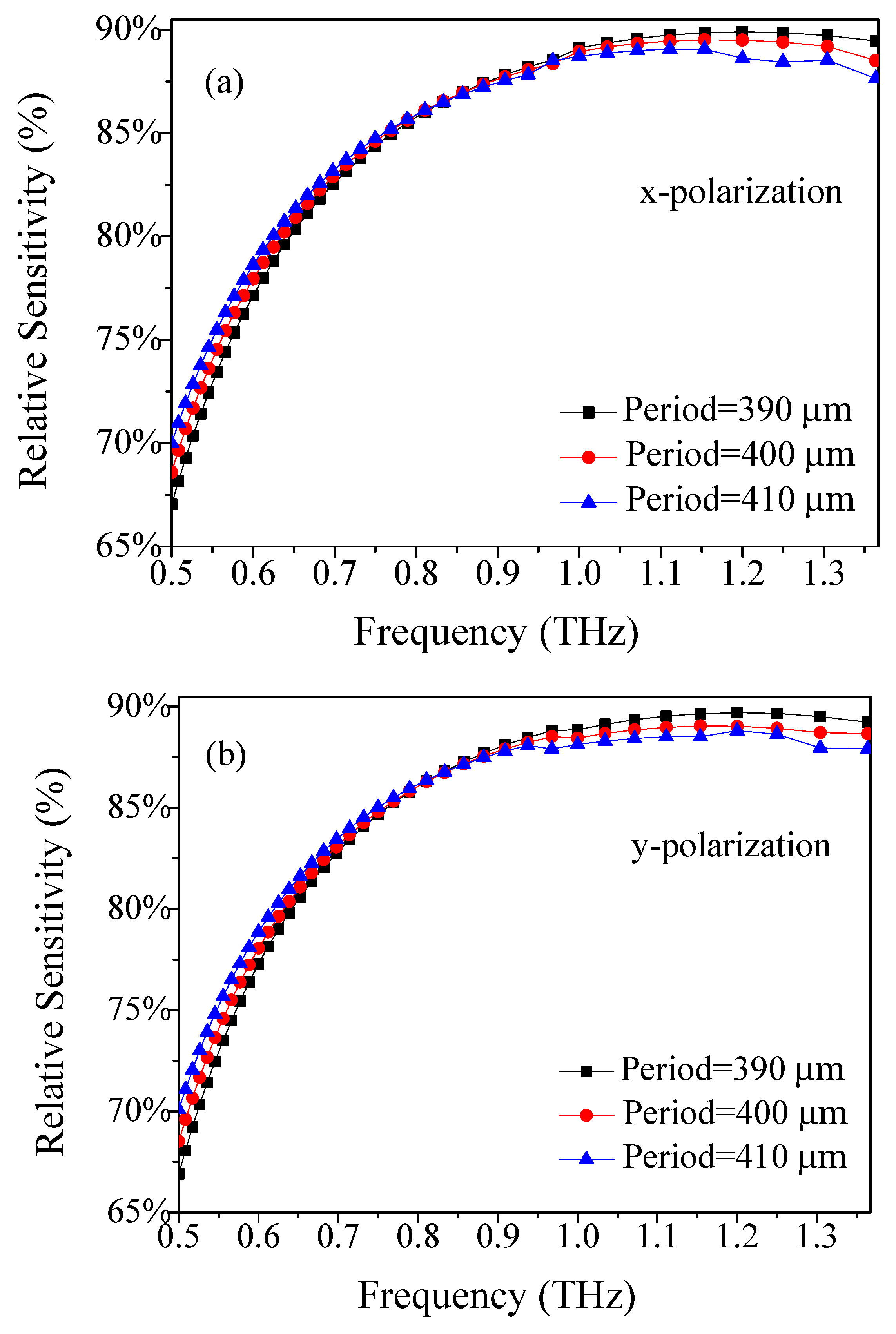

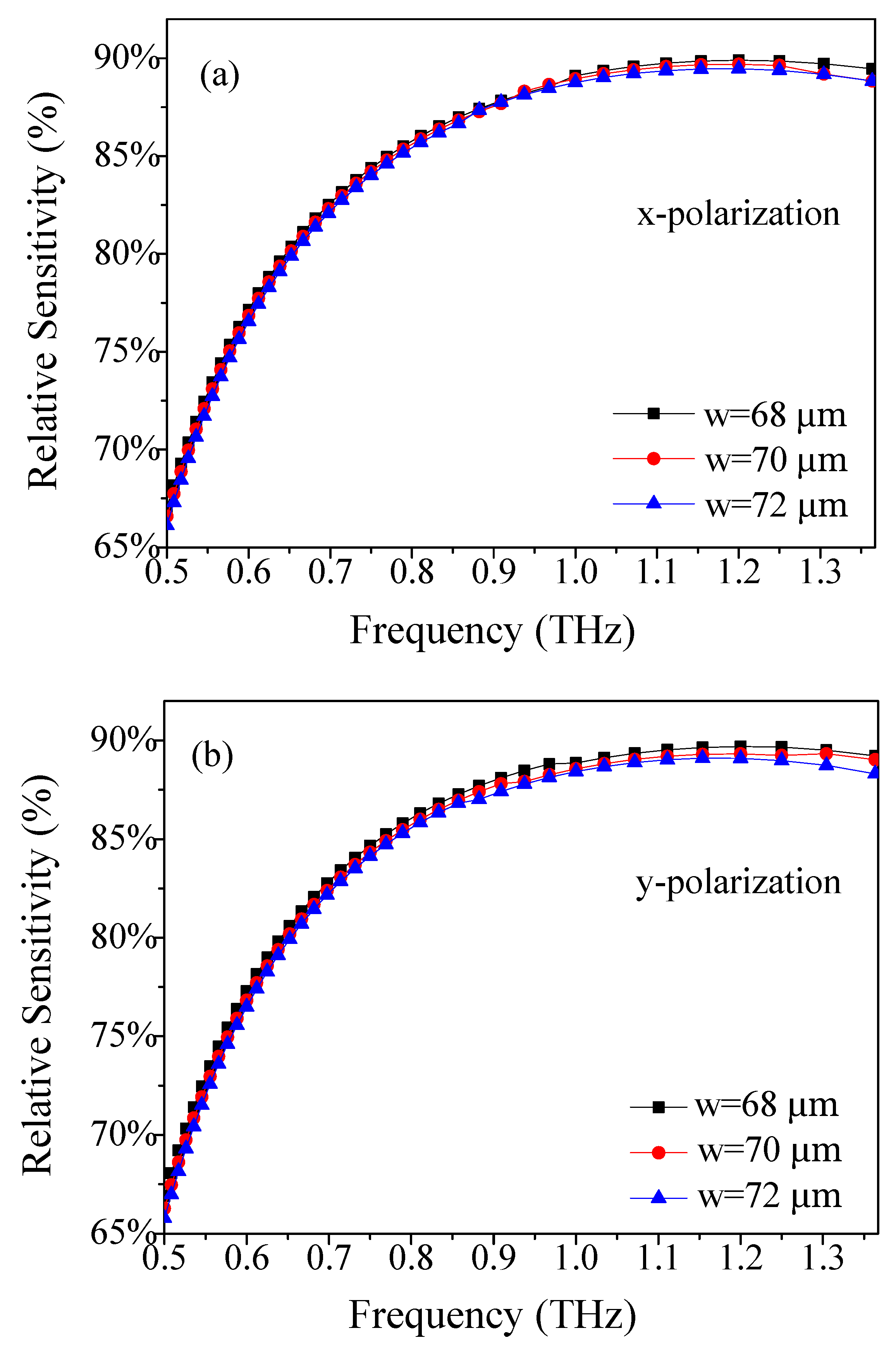
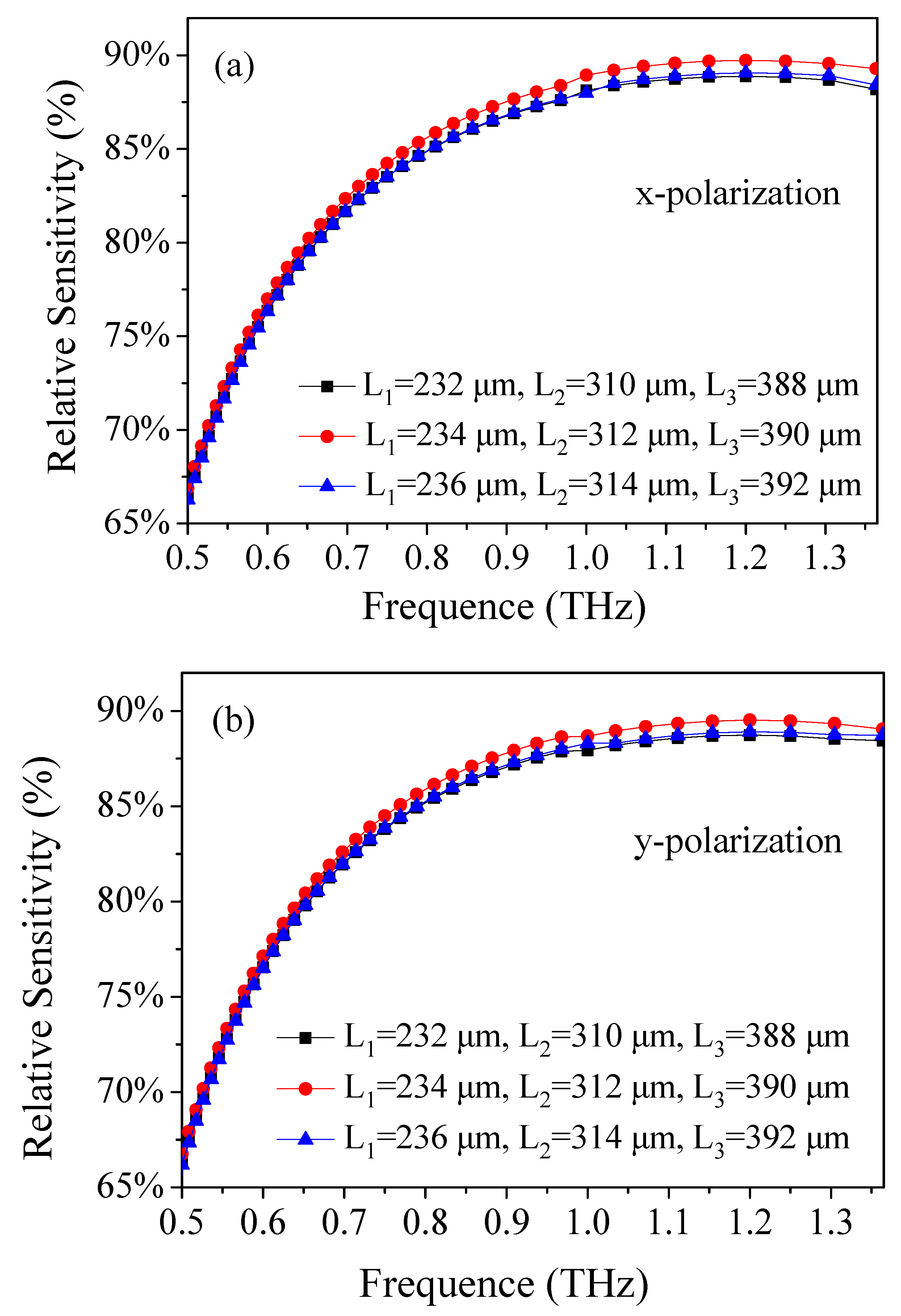
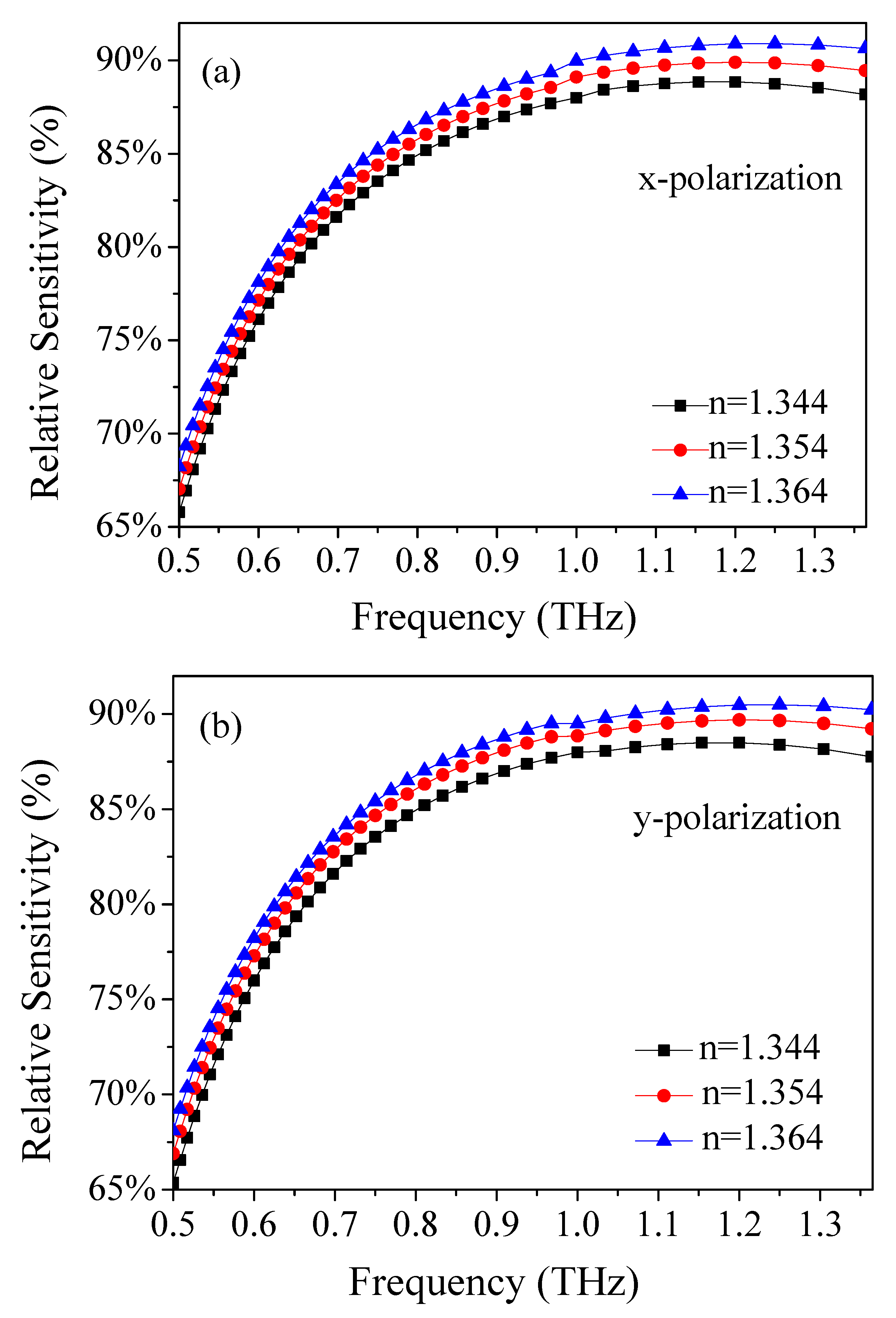
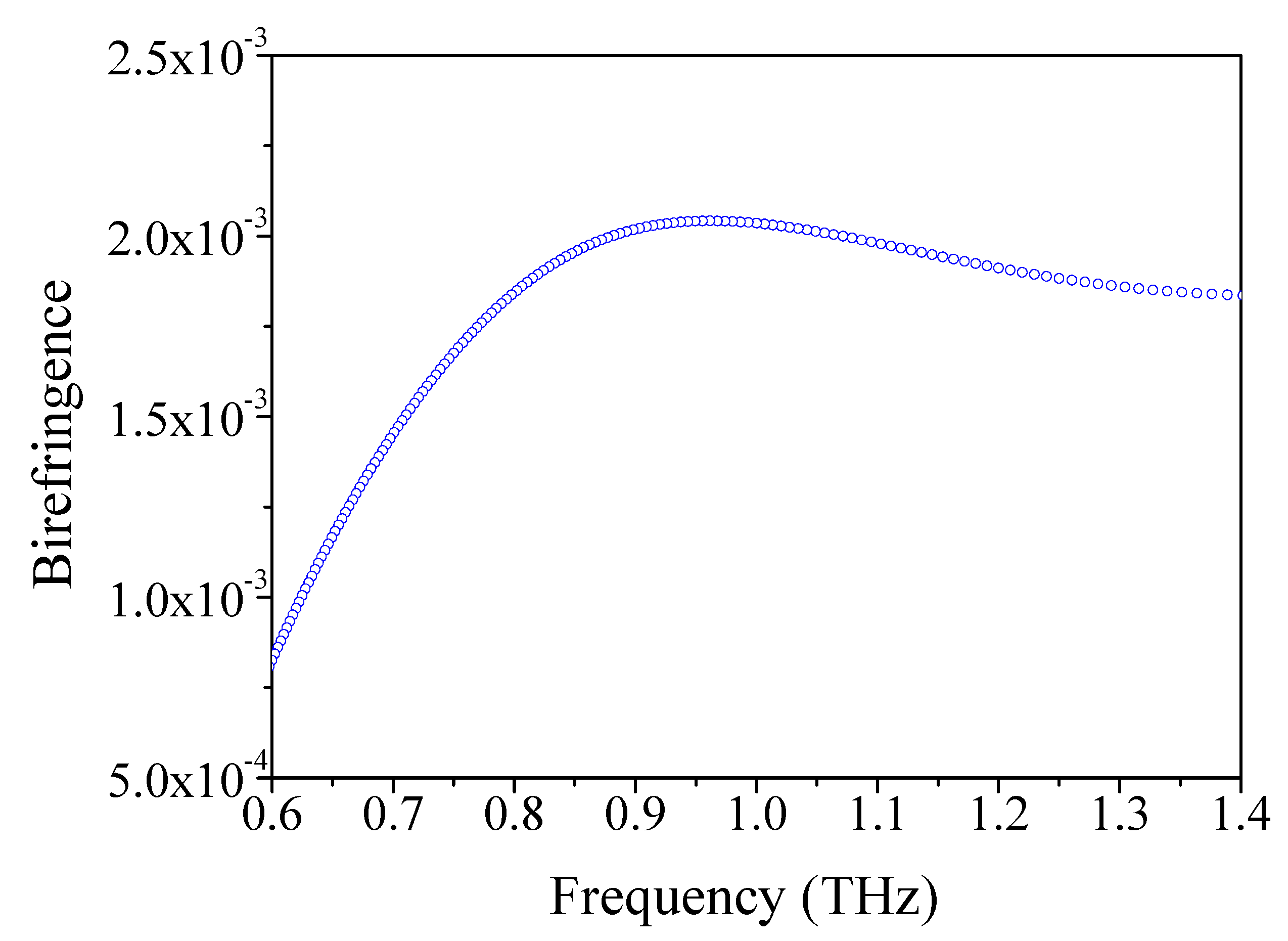
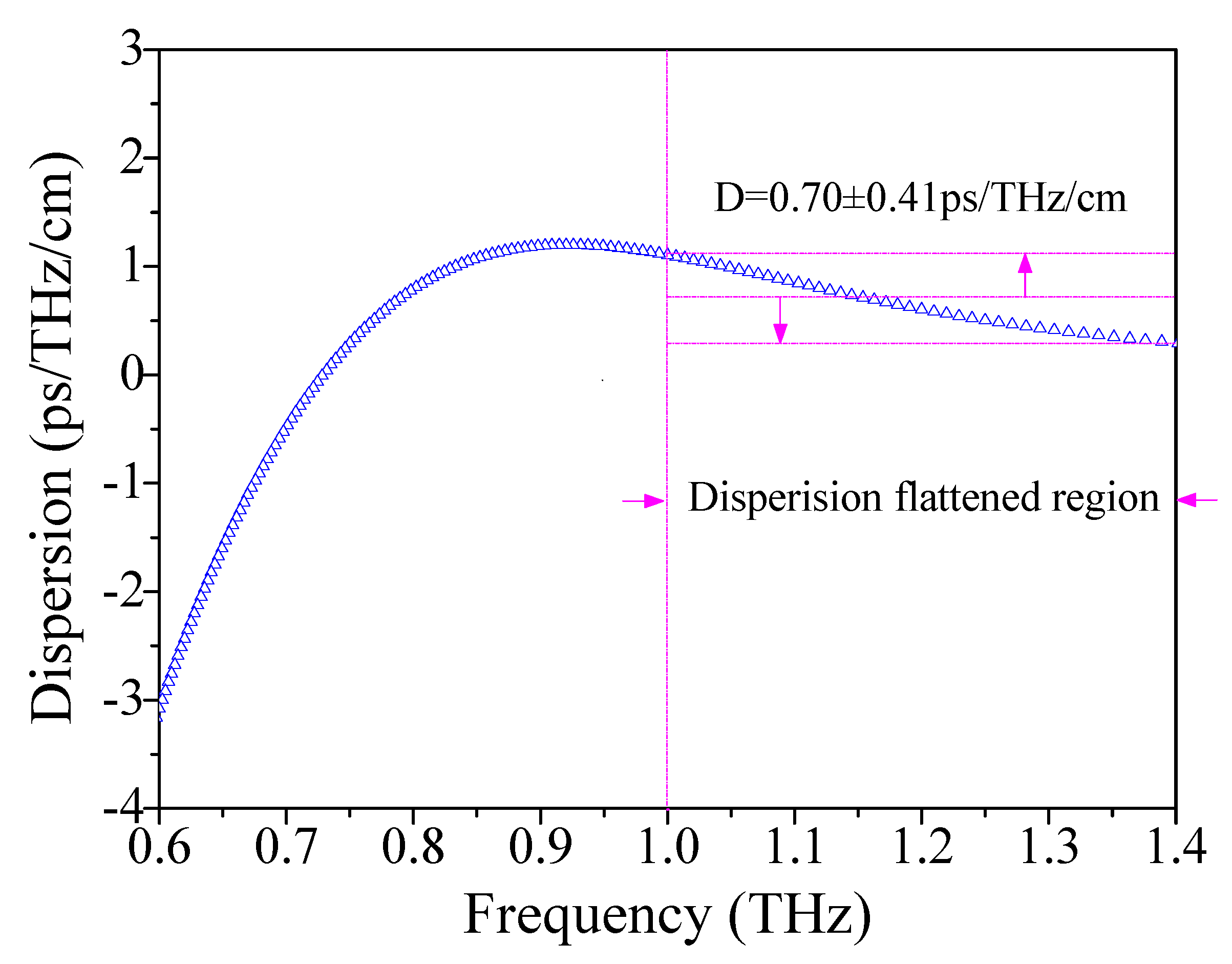
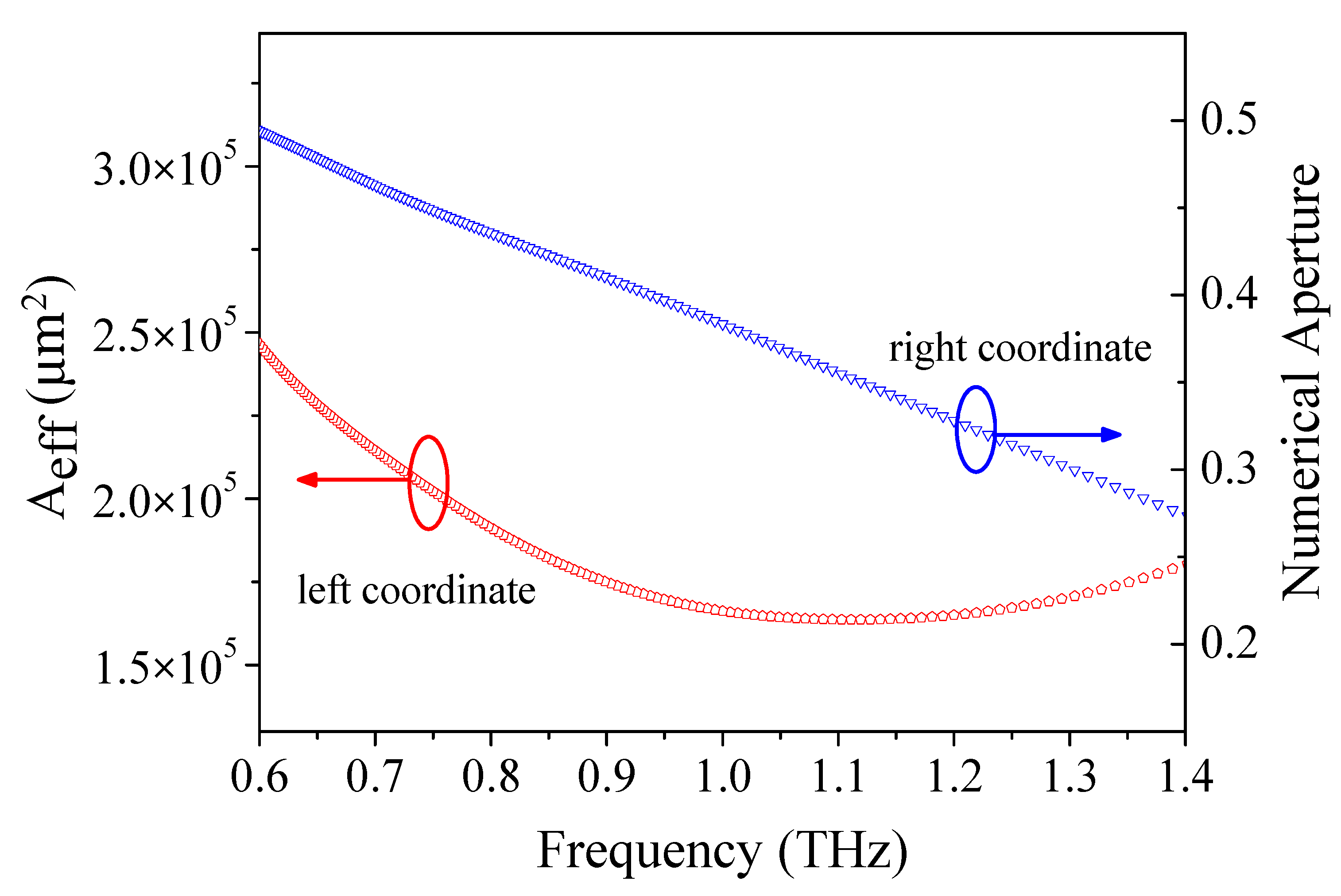
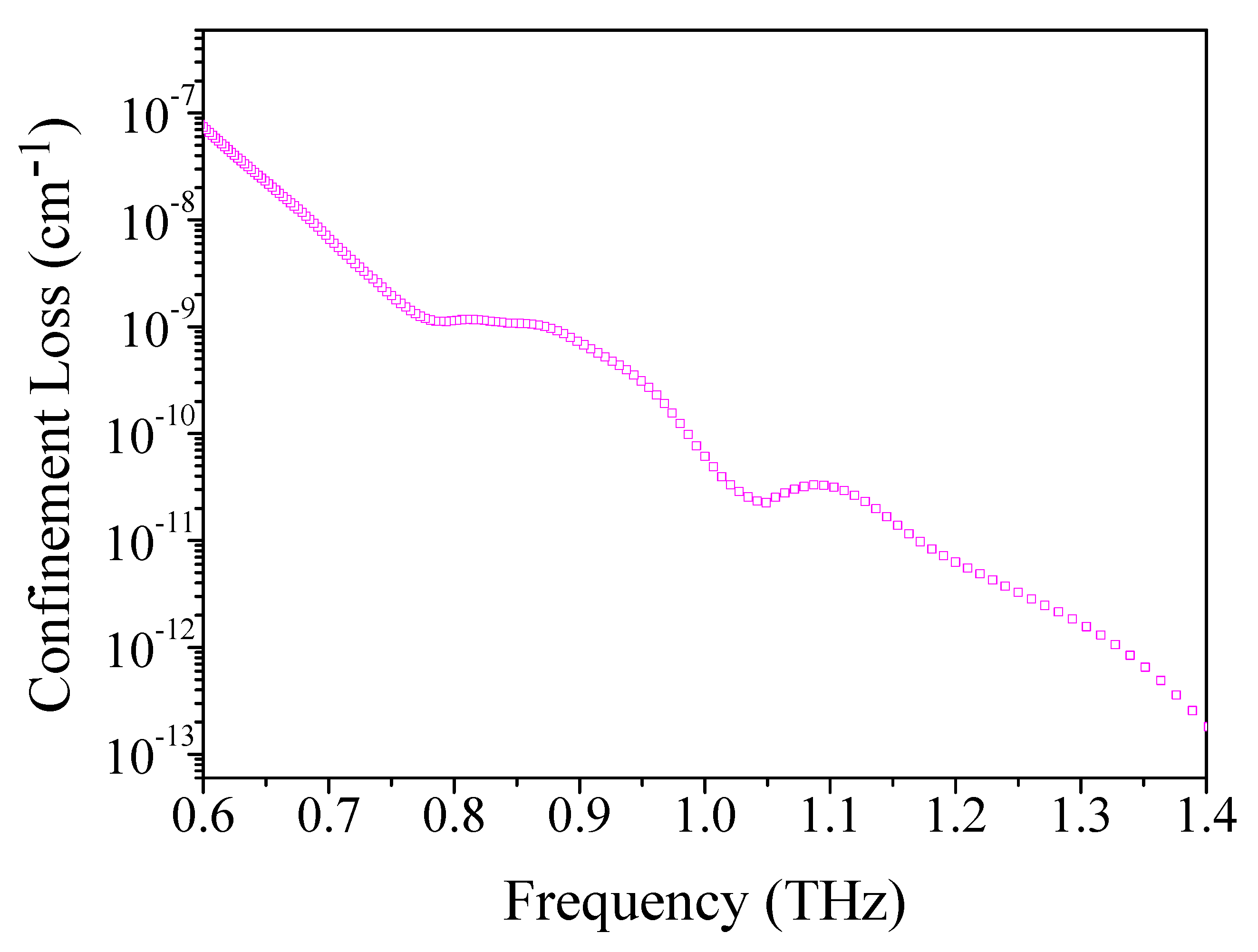

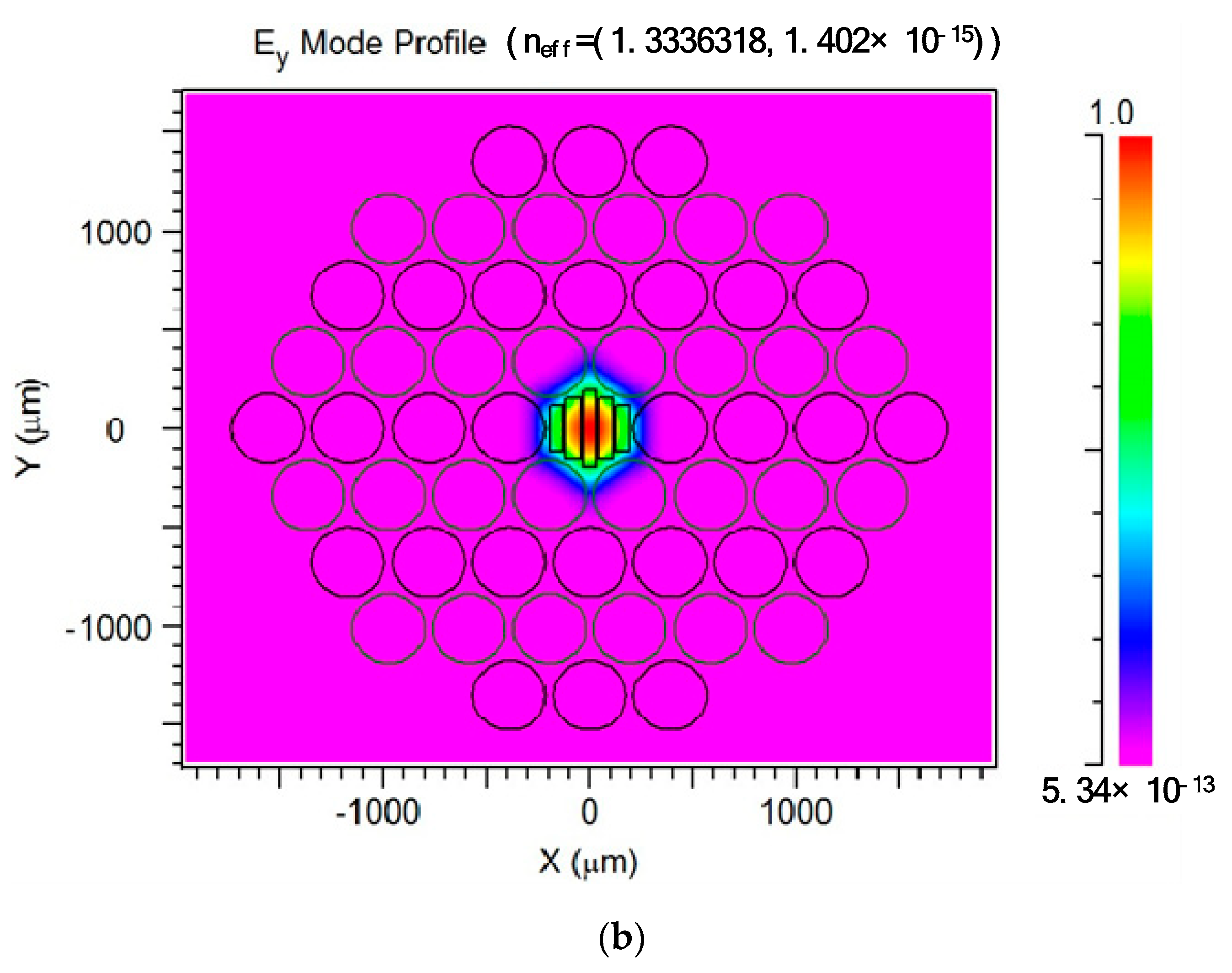
Publisher’s Note: MDPI stays neutral with regard to jurisdictional claims in published maps and institutional affiliations. |
© 2021 by the authors. Licensee MDPI, Basel, Switzerland. This article is an open access article distributed under the terms and conditions of the Creative Commons Attribution (CC BY) license (https://creativecommons.org/licenses/by/4.0/).
Share and Cite
Luo, W.; Jiang, P.; Xu, Q.; Cao, L.; Jones, A.; Li, K.; Copner, N.; Gong, Y. Terahertz Sensor via Ultralow-Loss Dispersion-Flattened Polymer Optical Fiber: Design and Analysis. Materials 2021, 14, 4921. https://doi.org/10.3390/ma14174921
Luo W, Jiang P, Xu Q, Cao L, Jones A, Li K, Copner N, Gong Y. Terahertz Sensor via Ultralow-Loss Dispersion-Flattened Polymer Optical Fiber: Design and Analysis. Materials. 2021; 14(17):4921. https://doi.org/10.3390/ma14174921
Chicago/Turabian StyleLuo, Wanli, Peng Jiang, Qiang Xu, Lei Cao, Adam Jones, Kang Li, Nigel Copner, and Yongkang Gong. 2021. "Terahertz Sensor via Ultralow-Loss Dispersion-Flattened Polymer Optical Fiber: Design and Analysis" Materials 14, no. 17: 4921. https://doi.org/10.3390/ma14174921
APA StyleLuo, W., Jiang, P., Xu, Q., Cao, L., Jones, A., Li, K., Copner, N., & Gong, Y. (2021). Terahertz Sensor via Ultralow-Loss Dispersion-Flattened Polymer Optical Fiber: Design and Analysis. Materials, 14(17), 4921. https://doi.org/10.3390/ma14174921




